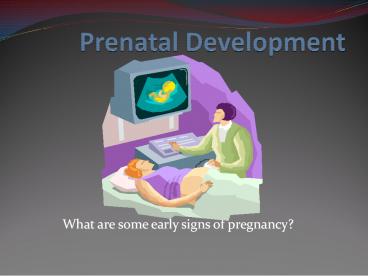Prenatal Development - PowerPoint PPT Presentation
1 / 36
Title:
Prenatal Development
Description:
What are some early signs of pregnancy? The Newborn Assessing the newborn: Apgar to assess newborns health; NBAS for a comprehensive assessment of infants 4 ... – PowerPoint PPT presentation
Number of Views:272
Avg rating:3.0/5.0
Title: Prenatal Development
1
Prenatal Development
- What are some early signs of pregnancy?
2
From Conception to Birth
- Period of the Zygote
- Period of the Embryo
- Period of the Fetus
3
Period of the Zygote
- Begins when egg is fertilized in the fallopian
tube. - Period of rapid cell division
- Ends 2 weeks later when the zygote is implanted
in the wall of the uterus
4
Period of the Zygote
5
Period of the Embryo
- From 3 to 8 weeks after conception
- Body parts are formed during this period
- Embryo rests in the amnion filled with amniotic
fluid - Umbilical cord joins embryo to placenta
6
Prenatal Structures
7
Period of the Fetus
- From 9 weeks after conception to birth
- Increase in size and systems begin to function
- Age of viability 22 to 28 weeks
8
First Month
- By the end of the first month, the embryo is
about 1/10 of an inch long. The heart, which is
no larger than a poppy seed, has begun beating.
9
First Month
10
Two Months
- The embryo is about 1 inch long and has distinct,
slightly webbed fingers. Veins are clearly
visible. The heart has divided into right and
left chambers.
11
Two Months
12
Three Months
- By now the fetus is 2 1/2 to 3 inches long and is
fully formed. He has begun swallowing and
kicking. All organs and muscles have formed and
are beginning to function.
13
Four Months
- Your baby is covered with a layer of thick, downy
hair called lanugo. His heartbeat can be heard
clearly. This is when you may feel your baby's
first kick.
14
4 months
15
Five Months
- A protective coating called vernix caseosa begins
to form on baby's skin. By the end of this month,
your baby will be nearly 8 inches long and weigh
almost a pound.
16
Six Months
- Eyebrows and eyelids are visible. Your baby's
lungs are filled with amniotic fluid, and he has
started breathing motions. If you talk or sing,
he can hear you.
17
6 Months
18
Seven Months
- By the end of the seventh month, your baby weighs
about 3 1/2 pounds and is about 12 inches long.
His body is well-formed. Fingernails cover his
fingertips
19
7 Months
20
Eight Months
- Your baby is gaining about half a pound per week,
and layers of fat are piling on. He has probably
turned head-down in preparation for birth. He
weighs between 4 and 6 pounds.
21
8 months
22
Nine Months
- Your baby is a hefty 6 to 9 pounds and measures
between 19 and 22 inches. As he becomes more
crowded, you may feel him move around less.
23
Influences on Prenatal Development
- General Risk Factors
- Teratogens Diseases, Drugs, and Environmental
Hazards - How Teratogens Influence Prenatal Development
- Prenatal Diagnosis and Treatment
24
General Risk Factors
- Nutrition adequate amount of food, protein,
vitamins, minerals - Stress decreases oxygen to fetus and weakens
mothers immune system - Mothers Age neither too young, nor too old
25
Teratogens Diseases, Drugs, and Environmental
Hazards
- Many diseases pass through the placenta directly
and attack the fetus - Potentially dangerous drugs not limited to
cocaine but include alcohol and caffeine - Environmental hazards are treacherous because
were often unaware of their presence
26
How Teratogens Influence Prenatal Development
- Not universally harmful
- Harm particular structures at a particular point
in development in particular animals
27
Effects of Teratogens
28
Prenatal Diagnosis and Treatment
- Diagnosis ultrasound, amniocentesis, and
chorionic villus sampling can detect physical
deformities and genetic disorders - Treatment fetal medicine and genetic engineering
are experimental
29
Prenatal Diagnosis
Amniocentesis
Chorionic Villus Sampling
30
Labor and Delivery
- Stage 1 starts when the muscles of the uterus
contract and ends when the cervix is fully
enlarged (about 10 cm) - Stage 2 baby is pushed down the birth canal
- Stage 3 placenta is expelled
31
Three Stages of Labor
32
Approaches to Childbirth
- Childbirth classes provide information about
pregnancy and childbirth - Childbirth classes teach pain control through
deep breathing, imagery, and supportive coaching - Mothers who attend classes use less medication
during labor and feel more positive about labor
and birth
33
Birth Complications
- Lack of oxygen (anoxia) Often leads to surgical
removal of the fetus (C-section) - Premature and Small-for-date infants
- Prematurity is less serious than small-for-date
34
The Newborn
- Assessing the newborn Apgar to assess newborns
health NBAS for a comprehensive assessment of
infants - 4 primary states alert inactivity, waking
activity, crying, sleeping - Half of newborns sleep is REM (deep sleep)
- Putting the baby to sleep on their back may
prevent SIDS
35
Postpartum Depression
- Half of all new moms feel some irritation,
resentment, and crying - 10-15 feel more severe postpartum depression
- Postpartum depression affects warmth and
enthusiasm of mothering
36
Happy Birthday!!!

